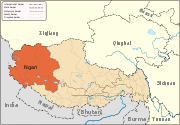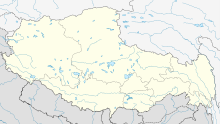- Ngari Gunsa Airport
-
Ngari Gunsa Airport
阿里昆莎机场
ལྷ་ས་གོང་དཀར་རྫོང་IATA: NGQ – ICAO: ZUAL Summary Airport type Military/Public Serves Shiquanhe Location Ngari (Ali), Tibet Elevation AMSL 4,274 m / 14,022 ft Coordinates 32°06′31″N 80°03′10″E / 32.10861°N 80.05278°ECoordinates: 32°06′31″N 80°03′10″E / 32.10861°N 80.05278°E Map Location of airport in Tibet Runways Direction Length Surface m ft 4,500 14,764 Asphalt Source: [1] Ngari Gunsa Airport (simplified Chinese: 阿里昆莎机场; traditional Chinese: 阿里昆莎機場; pinyin: Ālǐ Kūnshā Jīchǎng) is a dual-use military and civilian airport serving the town of Shiquanhe in Ngari Prefecture, in the southwest of China's Tibet Autonomous Region near the Indian border. It started operations on 1 July 2010, becoming the fourth civil airport in Tibet after Lhasa, Nyingchi, and Qamdo airports.[2]
Situated at 4,274 m (14,022 ft) above sea level, Gunsa Airport is the third highest airports in the world after Qamdo Bangda Airport (elevation 4,334 m (14,219 ft)) and Kangding Airport (elevation 4,280 m (14,042 ft)).[3][4] Gunsa airport has a 4,500-meter runway. It is expected to handle 120,000 passengers by 2020. Construction began in May 2007 and cost an estimated 1.65 billion yuan (241.22 million U.S. dollars).[2]
As Shiquanhe (Ali) is only a one-day bus drive (about 330 km) from the settlement of Darchen situated just north of Lake Mansarovar, facing Mount Kailash.[5] It is expected to benefit pilgrims to these two sites, which are considered sacred by Hindus,[6] Buddhists, Bonpa and Jains.[7][8] With the expected opening of Peace Airport in October, the five airports, coupled with the Qinghai–Tibet railway and a network of roads, are expected to increase tourism to scenic and holy sites in Tibet.[6]
With construction starting in 2011 and expected to be completed in 2014, the Nagqu Dagring Airport would surpass Qamdo Bangda Airport to become the world's highest altitude airport at 4,436 meters (14,554 ft) above sea level.[9]
Airlines and destinations
Airlines Destinations Air China Chengdu, Lhasa Tibet Airlines Chengdu, Lhasa Footnotes
- ^ 阿里昆莎机场
- ^ a b Tibet's fourth civil airport opens
- ^ The world’s third highest airport opens with milestone Airbus A319 flight
- ^ 西藏阿里昆莎机场迎来首航 为世界海拔第三高
- ^ Mayhew and Kohn (2005), p. 209.
- ^ a b "Pilgrims to benefit from new Tibet Airport near Mt Kailash."
- ^ Albinia (2008), p. 288,
- ^ Gyurme (199), p. 36.
- ^ World's highest-altitude airport planned on Tibet
References
- Albinia, Alice. (2008) Empires of the Indus: The Story of a River. First American Edition (2010) W. W. Norton & Company, New York. ISBN 978-0393-33860-7.
- Dorje, Gyurme. (2009) Tibet Handbook. Footprint Handbooks, Bath, England. ISBN 9781906098322.
- Mayhew, Bradley and Kohn, Michael. (2005) Tibet. 6th Edition. ISBN 1-74059-523-8.

Towns and villages Categories:- Airports in the Tibet Autonomous Region
- Tibet
Wikimedia Foundation. 2010.

